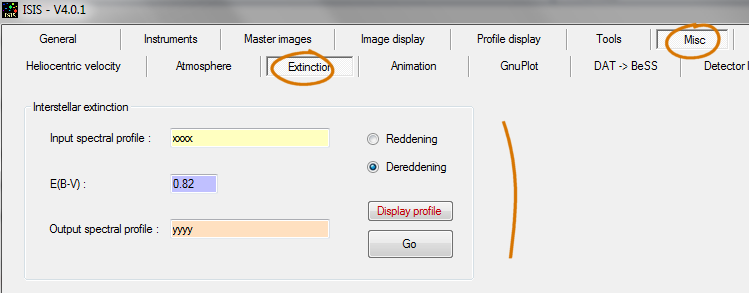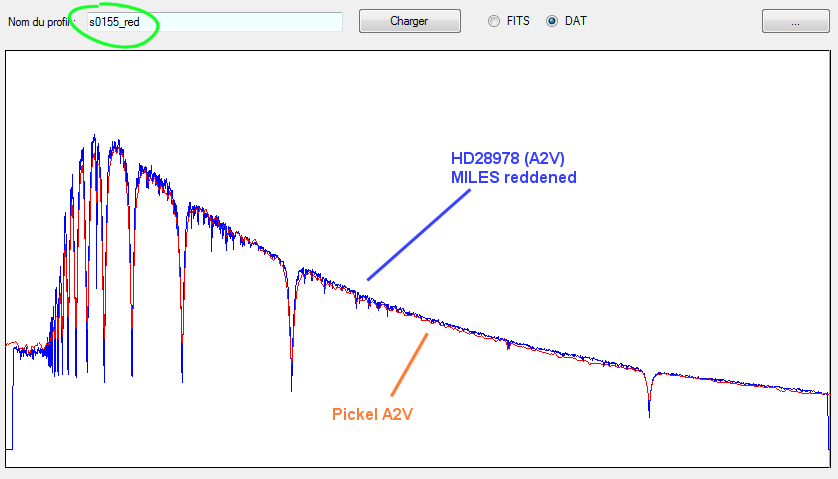Page 2 of 4
Re: About Miles data base
Posted: Sat Jan 28, 2012 10:21 am
by Christian Buil
Excellent job Marco and Paolo !
Note that I have decided on ISIS to implement a reddened version of MILIES library. It is an "observer" orientation option (direct access to the apparent spectral profile for help to compute instrumental spectral response). You have choice to load all spectra type or only A/B type (presently a undocumented function but you can access from new ISIS V4.0):

The Miles spectra are identified by the "m_" starting file name:
http://astrosurf.com/buil/isis/download ... ase_v4.zip
A tip: you can modify with a text editor the files miles.lst (full library V=7 limit) and miles2.lst (hot star) for add (or suppress) stars spectra for direct access from ISIS interface.
You can also compute individual spectra reddeding or de-reddening:

Cross-check for validation of algorithm implementation (Francois, Marco, Palo, ....) and suggestion are welcome.
Christian
Re: About Miles data base
Posted: Sat Jan 28, 2012 12:32 pm
by Christian Buil
I have a serious problem with MILES data base reddedening interpretation.
Here a comparison of HD28978 original ("de-reddened") MILES spectrum and a theoritical A2V star :

(Marco I have used your Excel application, but I have strickly the same result with ISIS implementation of MILES database)
Now the "reddened" version :

The theoritical A2V and HD28978 reddened are now identical. It's not normal

I have the same result with star HD141851 for example.
The MILES reddening seem inversed in some situation... ?!
An explanation ?
Christian
Re: About Miles data base
Posted: Sat Jan 28, 2012 1:05 pm
by Marco Leonardi
Christian,
yes it is not normal. Today I will discuss this issue with Paolo and if we have some explanation we will reply soon.
Regards,
Marco
Re: About Miles data base
Posted: Sat Jan 28, 2012 2:45 pm
by Paolo Berardi
Thank you very much for your spreadsheet examination Christian (also to Francois)!
Marco, Christian note that original Miles spectrum of a star A2V, de-reddened by astronomers on the basis of 0.117 color excess of the star, doesn't follows a reference A2V continuum.
The exact A2V coincidence with Miles spectrum 0.117 E(B-V) reddened (by our spreadsheet or ISIS) suggests that Miles spectrum was de-reddened two times or effective E(B-V) value is near to zero and original spectrum is not had to be corrected. But the causes may be other, I don't know...
Ciao
Paolo
Re: About Miles data base
Posted: Sat Jan 28, 2012 4:21 pm
by Francois Teyssier
I think there's important error for E(B-V) values. I said that in my document
For example, HD18191 : Miles takes 0.164, Stelib 0.35.
For 444 stars, Miles gets the values in littérature :
Savage, 1985
Silva, 1993
Gorgas, 1993
Carney, 1994
Alonso, 1996
Duck, 1996
Harris, 1996
Shuster, 1996
Twarog, 1997
Taylor, 1999
Beers, 1999
Dias, 2002
Stetson, 2003
(Only first author)
For 326 stars, Miles has computed the values from photometry
And for 144 ones, from Galactic Position.
On can use
http://irsa.ipac.caltech.edu/applications/DUST/ for such a computation
But values have a large amount of error, or are erroneous.
For example, IRSA gives E(B-V) = 2+/-0.3 for AE Aur, the published value is 0.53 and I found 0.59.
One can also compare the values used by MILES, wwith those of others spactral library such as STELIB.
For HD28978, the real E(B-V) must be 0.
Unfortunatly, non comparison : Jones 1997 produces non-deredened spectra. The star is also in Indo-US database which doesn't use E(B-V) index, but fit the observed spectrum with Pickles theorical spectrum. This the method I use. I think Indo-Us has a good idea

Another exmaple of discripancy between published values :
For SU Aur, one can found E(B-V) = 0 or 0.47 !!!
AB Aur : 0.05 or 0.26 !!
Note : the observed spectra (non dereddened) of Miles library can be download here :
http://www.star.uclan.ac.uk/~psb/webpag ... its.tar.gz
François
PS :
Congratulation for your very useful efficient and pédagogic speadsheet, Marco and Paolo
Re: About Miles data base
Posted: Sat Jan 28, 2012 6:34 pm
by Francois Teyssier
The study of STELIB is interesting.
http://www.ast.obs-mip.fr/users/leborgn ... stars.html
1. There's many values of Av that differs from published see HD42223, 36512, 91316 and so on
2. A number of spectra differ from the models (Pickles and Kurucz)
3. The correspondence is generally better with Kurucz model than with Pickles An example :
http://www.ast.obs-mip.fr/users/leborgn ... 8_moy.html
François Teyssier
Re: About Miles data base
Posted: Sat Jan 28, 2012 9:15 pm
by Christian Buil
Hum

, many coherence problems with MILES library concernant reddening (exact François, HD28978 extinction is probably near 0).
Finaly, my decision is to propose for ISIS the observed MILES spectra (thanks for reply the URL François) - the only probable correct option for compute instrumental response by using this library.
You can download the new ISIS database (just available release 5) from the main page:
http://astrosurf.com/buil/isis/isis_en.htm
Christian
Re: About Miles data base
Posted: Sat Jan 28, 2012 11:49 pm
by Martin Dubs
Hello
now I am completely confused. We have Miles, Miles non deredddened, Pickles, Kurucz and Stelib and all seem to give different values.
With Stelib there can be downloaded two versions, with dereddening and without:
http://www.ast.obs-mip.fr/users/leborgn ... files.html
Can they be converted by applying the quoted E(B-V) or Av? Do they use the same reddening law we have been using?
Francois, at least in the case of HD20041 this library did not give the non dereddenend spectrum, as I noticed in my mail of Jan. 9.
Is there a way out of this mess? Maybe a list of useful stars, where different sources agree on the reddening and the observed spectrum?
Regards, Martin
Re: About Miles data base
Posted: Sun Jan 29, 2012 11:30 am
by Marco Leonardi
Hello,
me and Paolo have decided to use the last database that kindly François has linked in the above post (the original observed spectra no-dereddened of Miles library). Because in this new database (Miles non dereddened) the file are fits, me and Paolo will convert all the files in dat using ISIS, so that we can use them in the excel. We are doing this job just today and most probably pretty soon we will load in ARAS the new excel file. In the new excel file it will be possible to load the no-dereddned profile but it will possible to apply de-reddening so that one can study/use both.
Marco and Paolo
Re: About Miles data base
Posted: Sun Jan 29, 2012 5:40 pm
by Francois Teyssier
There's almost no difference between Cardelli and Fitzpatrick "laws".
AE Aur dereddened with Cardelli law :
The attachment AEAur_Cardelli.PNG is no longer available
AE Aur dereddened with Fitzpatrick (Miles algorithm, using Fitzpatrick values)
The attachment AEAur_Cardelli.PNG is no longer available
Stelib : Leborgne & al. 2003 : very few information about interstellar correction.
As Stelib uses Av, one can suppose that the law is A(lamda)/Av
The observed spectrum of HD20041 is in the Miles library (s0110.test)
[Martin : I haven't seen in your mails of Jan. 9 that the HD20041 wasn't in observed Miles library ?]
Here's comparison between Christian and Miles observed spectra, using VSpec :

- HD20041_MilesObserved_Buil.PNG (11.82 KiB) Viewed 11474 times
There's little difference between intrumental/atmospheric correction.
Up to date, we can say :
- use only E(B-V) = 0 stars to compute the instrumental response
- when the continuum of a processed spectrum doesn't mathche with the theorical spectrum, one must considerer a possible difference in color excess index between the starused to compute intrumentral response and the observed star.
Best regards
François Teyssier





